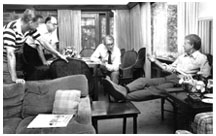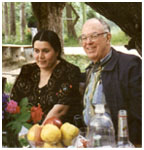December 5, 2001: Features
Forging
trust, bringing peace
Harold Saunders
’52’s process brought stability to Tajikistan. Can it work in
Afghanistan?
By Alex Rawson ’01
 Photo:
Top right, from left, National Security Adviser Zbigniew Brzezinski, Harold
Saunders ’52, Secretary of State Cyrus Vance, and President Jimmy
Carter at Camp David in 1978. Lower, Saunders, center, with Tajik colleagues.
Photo:
Top right, from left, National Security Adviser Zbigniew Brzezinski, Harold
Saunders ’52, Secretary of State Cyrus Vance, and President Jimmy
Carter at Camp David in 1978. Lower, Saunders, center, with Tajik colleagues.
When Harold Saunders ’52 sat down with 12 leaders of war-torn Tajikistan in 1993, tensions were so high “members found it difficult to look at each other,” he recalls. But eight years and 32 conversations later, Tajikistan has what Saunders calls “the only legitimate Islamic government in Central Asia.”
Credit “sustained dialogue,” a process developed by Saunders that brings all sides of a conflict together in an ongoing series of discussions to build trust and develop actionable solutions — outside government. “There are some things,” Saunders explains, sitting on a tired ivory couch in his office at the Kettering Foundation, “that governments can’t do.”
 Saunders
should know. He spent 20 years with the U.S. government negotiating and
mediating peace in the Middle East and Central Asia — first as a
member of the National Security Council from 1961 to 1974, and then as
a top State Department official during the Ford and Carter administrations.
By the time he left government in 1981, he had helped mediate the Camp
David accords and the Egypt-Israeli Peace Treaty of 1978—79, he had
helped negotiate the Iranian hostage crisis and a host of conflicts between
India and Pakistan, and he had emerged as a leader in U.S./Soviet relations.
Saunders
should know. He spent 20 years with the U.S. government negotiating and
mediating peace in the Middle East and Central Asia — first as a
member of the National Security Council from 1961 to 1974, and then as
a top State Department official during the Ford and Carter administrations.
By the time he left government in 1981, he had helped mediate the Camp
David accords and the Egypt-Israeli Peace Treaty of 1978—79, he had
helped negotiate the Iranian hostage crisis and a host of conflicts between
India and Pakistan, and he had emerged as a leader in U.S./Soviet relations.
Most of those negotiations were dubbed successes, but Saunders realized that lasting peace required more than government intervention. “Conflict is not just a clash among institutions,” he explains. “Nor is peace made by governments alone.” Peace, in Saunders’s view, requires trust on a human dimension that governments, almost of necessity, cannot achieve. The government-led Egypt-Israeli Treaty was only possible, for instance, once Israelis became convinced on a personal level that Egypt’s Sadat genuinely wanted peace. This type of shift, what Saunders terms “relationship transformation,” can only happen via continuous interactions between people, not between states. In his book A Public Peace Process: Sustained Dialogue to Transform Racial and Ethnic Conflicts (St. Martin’s Press, 1999), Saunders writes, “We need to focus on the totality of interactions between whole groups — not just on the strategic chess game between states seen as rational actors.”
It is in that spirit that Saunders, now director of international affairs at Kettering, a foundation that researches the workings of democracy, developed the sustained dialogue model. Saunders’s first direct exposure leading such a process was as cochair of the Dartmouth Conference during the 1980s. Sponsored on the U.S. side in large part by Kettering, the conference began as a series of dialogues between Soviet and U.S. civilians in 1960, and over 30 years made great strides in improving the relationship between the two countries. During Saunders’s tenure he led, with future Russian Prime Minister Evgeny Primakov, a smaller Regional Conflicts Task Force.
Buoyed by the Dartmouth Conference’s success, Saunders — together with the task force, colleagues from Kettering (which he joined full time in 1991), and several others from around the world — applied the same sustained dialogue process to piece back together Tajikistan. Saunders believes that sustained dialogue can and should be employed in the same way in neighboring Afghanistan.
There are significant similarities between the two Central-Asian countries. Tajikistan, long under Soviet control, has as much ethnic factionalism as does Afghanistan. In fact, after Tajikistan gained independence in 1991, enough Tajikistanis fled from the ensuing factional warfare that by 1993 Afghanistan — particularly in the north — was nearly 25 percent Tajik. Perhaps most important, Tajikistan and Afghanistan are both engaged on some level in serious internal conversations to attempt to reconcile Islam with democracy, though Tajikistan has advanced farther along that path — in large part due to sustained dialogue.
The sustained dialogues in Tajikistan began in 1993, when Saunders and his colleagues brought together leaders from the many factions of the nation to begin to build a relationship. Newly independent Tajikistan faced civil war and a military dictatorship that used public executions and murder
to maintain fear and stifle opposition — much like the Taliban in Afghanistan. Add to that a number of equally uncooperative opposition groups, and it’s no surprise that the initial meeting of the sustained dialogue group was a difficult and distrustful one.
The first step of the process was to decide to participate — and finding that initial impetus was in some sense the most difficult part. Once the dialogue was established, though, participants, moderated by Saunders and his team, worked in discussions to define the problems at stake and to understand the various perspectives around the table. As trust within the group grew, they began to develop strategies for solving those problems and concrete steps to implement those strategies. By 1997, the civil war in Tajikistan had finally ended, and now, after 32 meetings, many members of the sustained dialogue group play significant roles in a fledgling and developing democratic government.
Moreover, the initial dialogue group has now set up a second dialogue without third-party moderators, demonstrating the degree to which sustained dialogues have improved cooperation and communication in Tajikistan. Concludes Saunders, “The Tajikistan process has been very exciting.”
Saunders believes that with the Taliban significantly weakened, a third-party moderator could begin the sustained dialogue process in Afghanistan just as Saunders and his team did in Tajikistan. Saunders stresses that any American moderator must be wholly separate from the U.S. government, because mistrust of the U.S. government in the region is significant enough that a government-led dialogue would create additional barriers. He mentions, however, that one of the members of the Tajikistan team spent years in Afghanistan before the war with the Soviets and has already conducted some dialogues within Afghanistan, and Saunders contends that he could lead a sustained dialogue for a new government coalition there. That dialogue, according to Saunders, would include key leaders of the five or six factions in Afghanistan, including moderate members of the Taliban. Over time, that would force out any lingering extremist ideologies. “Getting extremists into something like this is not something you can do,” Saunders explains. “You have to broaden the circle of moderates to squeeze out extremists.”
Once the extremist positions have been weakened, Saunders says, the true dialogue process could begin in full. And Saunders notes that the necessary political mechanisms to begin that dialogue are in fact already in place: Afghanistan has a group, the “Loiajirga,” that includes each faction with an interest in the future of the country in a way that resembles the U.S. Constitutional Convention. That group need only be summoned, and from there sustained dialogue could begin. Saunders’s hope is that as trust builds over time, Afghanistan, too, could begin to develop an Islamic democracy and a functioning, institution-based, developable civil society. “This cannot, however, be a mediated agreement from the outside,” Saunders cautions. “We must work to bring people together to moderate themselves, and see what their capacities are.” In other words, the peace-building process in Afghanistan, at least in the longer term, must exist in cooperation with but strongly separate from U.S. government efforts.
Saunders believes that unseating
the Taliban was an important early step. But as governments scramble to
build a tenuous coalition in Afghanistan, he argues that without an accompanying
sustained dialogue, the new regime will last no longer than the old one
did. ![]()
Former On the Campus columnist Alex Rawson ’01 lives in Washington, D.C.
Rawson will contribute a periodic Letter from Washington on PAW Online Columns.
